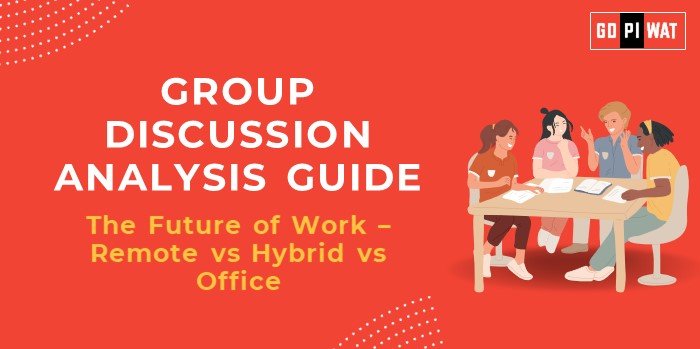📋 Group Discussion Analysis Guide on “The Future of Work – Remote vs Hybrid vs Office”
🌐 Introduction to “The Future of Work – Remote vs Hybrid vs Office”
The COVID-19 pandemic transformed work dynamics globally, sparking a debate on the best working model for the future—remote, hybrid, or fully office-based. Each model has unique benefits and challenges, influencing productivity, work-life balance, and company culture.
Topic Background: With technological advancements enabling remote collaboration, organizations now have flexible options. The question remains: which model maximizes efficiency and employee satisfaction in the long run?
📊 Quick Facts and Key Statistics
- 🔄 Work Model Adoption Rates:
- Hybrid Work: 49% of global desk-based workers now work in a hybrid model, making it the dominant arrangement among current options.
- Full-Time Remote: Only 17% work fully remote, while 35% continue in traditional in-office settings.
- 📈 Productivity and Engagement:
- Hybrid Workers report the highest engagement levels at 35%, followed by fully remote employees at 33%, and in-office employees at 27%, highlighting the motivational benefits of hybrid arrangements.
- Productivity Increase: Employees with flexible location options show an 81% higher productivity score, reinforcing the advantages of hybrid and remote models in enhancing work performance.
- 💸 Cost Savings:
- Employer Savings: Organizations save an estimated $11,000 annually per employee on hybrid models, thanks to reduced office space and commuting expenses.
- Employee Savings: Employees working remotely part-time can save between $2,500 and $4,000 each year, with greater savings for those who relocate to lower-cost areas.
- 🌍 Environmental Impact:
- Carbon Footprint Reduction: Remote work has a significant environmental benefit. Employees who work remotely four or more days a week reduce their carbon footprint by up to 54%, while those working up to four days a week achieve up to 29% reduction.
- Commuting Savings: Half-time remote work could achieve the greenhouse gas reduction equivalent of removing all New York State employees from daily commutes.
- 📊 Employee Preferences and Retention:
- Increased Retention: Remote work reduces quit rates by up to 35%, and 43% of employees would consider leaving if required to be on-site full-time.
- Value of Flexibility: Employees value flexible work options as much as an 8% salary increase, with the highest value placed on hybrid arrangements in tech and finance sectors.
👥 Stakeholders and Their Roles
- Employers and HR Leaders: Redefining policies, adapting workplaces, and ensuring team cohesion across models.
- Employees: Balancing work preferences with productivity, engagement, and career growth opportunities.
- Governments and Regulators: Developing guidelines around remote work rights, tax policies, and digital security.
- Technology Providers: Innovating tools and platforms to facilitate seamless remote and hybrid collaboration.
🎯 Achievements and Challenges
- Achievements:
- Employee Satisfaction: Flexible work options have improved employee satisfaction and work-life balance.
- Cost Savings: Remote work has helped companies save on operational costs, including real estate and utilities.
- Talent Pool Expansion: Employers can now recruit talent beyond geographic limitations, boosting diversity.
- Challenges:
- Reduced Team Cohesion: Office-based models allow for better face-to-face collaboration, which can suffer in remote setups.
- Digital Fatigue: Prolonged remote work has led to burnout and challenges in maintaining work-life boundaries.
- Data Security Risks: Increased digital dependency has heightened security and privacy risks.
🌏 Global Comparisons
- Japan: While remote work uptake remains relatively low, there’s a slow shift toward hybrid options, especially in tech sectors.
- Netherlands: High remote work adoption due to strong digital infrastructure and progressive policies.
📝 Case Study
India’s IT Sector: Top firms like TCS and Infosys implemented hybrid work to retain flexibility while maintaining productivity.
🗣️ Structured Arguments for Discussion
- Supporting Stance: “Remote and hybrid work models enhance employee well-being, productivity, and environmental sustainability.”
- Opposing Stance: “Office-based work ensures stronger teamwork, quick decision-making, and better control over productivity.”
- Balanced Perspective: “Each model has distinct advantages; a flexible approach based on company needs and employee roles may be optimal.”
🎤 Effective Discussion Approaches
- Opening Approaches:
- Statistical Insight: “With 49% of global workers now on a hybrid schedule, it’s clear that the future of work is evolving beyond traditional norms.”
- Comparative Insight: “While hybrid models offer flexibility, companies like Tesla emphasize the productivity benefits of in-office work.”
- Counter-Argument Handling: Use real-world data or case studies to balance perspectives, e.g., citing productivity stats for remote work when discussing office limitations.
🔍 Strategic Analysis of Strengths and Weaknesses
- Strengths: Flexibility, increased talent pool, cost savings.
- Weaknesses: Risk of isolation, potential loss of company culture.
- Opportunities: Technological advancements, personalized work policies.
- Threats: Digital security risks, potential regulatory challenges.
📚 Connecting with B-School Applications
- Real-World Applications: The topic relates to human resources, operations management, and strategic leadership.
- Sample Interview Questions: “What work model do you believe is most effective for organizational productivity?” “How can companies mitigate the downsides of remote work?”
- Insights for B-School Students: Understand how work models impact employee satisfaction and productivity. Research digital security and regulatory implications in remote work.


